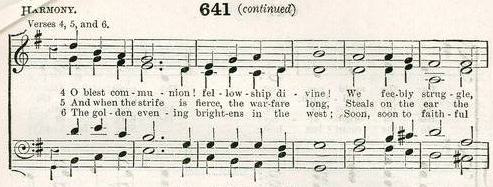 |
| SOURCE: scan of Oeser ed., p. 1 (detail, with emphasis added) |
The instruments are regarded as interchangeable, probably because the cornet (properly with accent on the first syllable, which makes it easily distinguished from the cornett) is virtually an endangered species, particularly in the USA. A hundred years ago it was the other way around, and the trumpet seems to have taken over in the 1920s (with perhaps the coup de grâce being Louis Armstrong’s conversion to trumpet). Thus we find Cecil Forsyth, writing in his Orchestration (1914/rev. 1935):
We must not forget that the contempt which is usually bestowed on the Cornet by those who have never heard it properly played is mainly a contempt because it cannot equal or beat the Trumpet in Trumpet passages. These simple and straightforward phrases were always consciously designed by the old masters to produce their somewhat oppressive effect by the mere weight of the instrument’s tone. In course of time we have come to associate that type of tone with that type of passage. (p. 107)Erring on the side of oversimplification, the conical cornet is a melody instrument; the cylindrical trumpet is a rhythmic instrument, with a tone better able to cut through an ensemble. To best illustrate the timbral difference between conical and cylindrical brass I suggest this performance of the piece we usually call “Jesu, Joy of Man's Desiring” (from BWV 147) by the German Brass. The arranger has cleverly divided the ensemble into a two distinct consorts. For most of this arrangement, the 4-part chorale is played by cylindrical instruments (one trumpet and three trombones), while the rest is played by conical instruments (two flugelhorns, two horns, tuba—although at a two points a piccolo trumpet joins in, and in the final measures everyone is playing together).
Here is a handy diagram, from Anthony Baines’s Oxford Companion to Musical Instruments (1992), which compares the profile of several brass instruments, although it warrants a few comments below.
 |
| SOURCE: detail of scan of Baines, p. 43 (entry: Brass instruments). Baines does not clarify this, but this diagram must assume that no valves are depressed, nor is the trombone slide extended; V then would indicate the passage through the valve section of the instrument, but not diverted through the crooks the valves would engage. Otherwise the proportions don't make sense, as (for example) nos. 4 and 5 at their full length would be much closer to #1. |
Note that profile 6 above is only the shorter portion of the standard “double” horn today (F/B-flat); the F side would extend off well to the right, and would thus be proportionally more cylindrical. For orchestral horns, the principle that the longer the instrument is the more cylindrical its profile has always been true: even before valves, with the crooks players would use to change the key of the instrument, the low crooks produce a very different sound from the high crooks. Listen, for example, to these recordings of the opening chorus of Bach's cantata Sie werden aus Saba alle kommen (BWV 65) with either C alto or C basso horns:
- C alto: Gabrieli Consort (dir. Paul McCreesh)
- C basso: Amsterdam Baroque Orchestra (dir. Ton Koopman)
It isn’t just the pitch, but the whole timbre of the instrument that is changed. At the extreme: the shortest horns of which I am aware are the E-flat alto horns in Mozart’s K. 132 (the higher pair of two pairs of horns), which make a very round, bugle-ish sound.
In the ensembles that put pairs of cornets and trumpets together—as so often in French nineteenth-century literature, or in military band music—one may frequently find composers observing a distinction between the writing appropriate for one or the other. Thus in his wind band piece Sea Songs, Ralph Vaughan Williams neatly distinguishes between cornet solos and trumpet solos, and (as below) demonstrates how to keep trumpet punctuation from overwhelming cornet lyricism, while still sometime needing either instrument to function as the other:
 |
SOURCE: scan of Sea Songs full score (Boosey & Co, "corrected edition 1991"), pp. 20-21 (composite details) |
 |
| SOURCE: scan of pp. 112-13 of 1997 Dover reprint of 1884 first edition of España (composite details; accolade added) |
But in other instances where one might expect such a practice, it just doesn’t happen. In Gilbert & Sullivan’s Iolanthe, for example, the fanfares which begin the chorus “Loudly let the trumpet bray” are played by cornets, Sullivan’s default in the Savoy Theatre orchestra. (Like Bizet’s Opéra Comique, this may have been a balance issue more than anything else; when Sullivan wrote his grand opera Ivanhoe, he called for trumpets—and even a Wagnerian bass trumpet.) Seldom do I hear cornets in performances of the Savoy operas. The rare cornet solo does strike my ear as odd on the trumpet, though. Compare the solo in the overture of The Pirates of Penzance (by Sullivan's assistant, Alfred Cellier) in these two performances, one with trumpet (at least to my ear, although the player is trying to compensate with a fair bit of vibrato) and the other with cornet. I note that the Kalmus score (apparently scored from parts) gives no indications that the cornet was what Sullivan had in his ensemble:
 |
| SOURCE: scan of undated Kalmus full score of The Pirates of Penzance, p. 3 (detail) |
I started this post remarking on performers disregarding the instructions of a composer, and have given a few examples of editors doing it. I have been wondering if we could imagine an editor imposing cornet where a composer wrote trumpet? Has this ever been done—outside of brass band transcriptions? I can think of a place where I’d like to do it: the “Tango-Pasodoblé” movement of Walton’s Façade.
 |
| SOURCE: scan of William Walton Edition vol. 7, Façade Entertainments, p. 42 (detail) |








